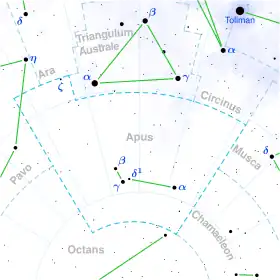 | |
| Observation data Epoch J2000.0 Equinox J2000.0 (ICRS) | |
|---|---|
| Constellation | Apus |
| Right ascension | 17h 16m 35.64850s[1] |
| Declination | −74° 31′ 58.8407″[1] |
| Apparent magnitude (V) | 6.23±0.01[2] |
| Characteristics | |
| Spectral type | A0 V[3] |
| U−B color index | +0.00[4] |
| B−V color index | −0.01[4] |
| Astrometry | |
| Radial velocity (Rv) | −3.1±2[5] km/s |
| Proper motion (μ) | RA: −23.266 mas/yr[1] Dec.: −53.910 mas/yr[1] |
| Parallax (π) | 9.6961 ± 0.0359 mas[1] |
| Distance | 336 ± 1 ly (103.1 ± 0.4 pc) |
| Absolute magnitude (MV) | +1.11[6] |
| Details | |
| Mass | 2.56+0.39 −0.29[7] M☉ |
| Radius | 2.08±0.11[8] R☉ |
| Luminosity | 42[1] L☉ |
| Surface gravity (log g) | 4.24±0.06[7] cgs |
| Temperature | 9,772+228 −222[9] K |
| Metallicity [Fe/H] | −0.11[10] dex |
| Age | 330±2[11] Myr |
| Other designations | |
| Database references | |
| SIMBAD | data |
HD 154972, also known as HR 6373 or rarely 56 G. Apodis, is a solitary, bluish-white-hued star located in the southern circumpolar constellation Apus. It has an apparent magnitude of 6.23,[2] placing it near the limit for naked eye visibility. Gaia DR3 parallax measurements place the object 336 light years away,[1] and it is currently drifting closer with a heliocentric radial velocity of −3.1 km/s.[5] At its current distance, HD 154972's brightness is diminished by 0.23 magnitudes due to extinction from interstellar dust.[14] It has an absolute magnitude of +1.11.[6]
This is an ordinary A-type main-sequence star with a stellar classification of A0 V.[3] Paunzen et al. (2001) lists it as a potential λ Boötis star.[15] It has 2.56 times the mass of the Sun[7] and 2.08 times its solar radius.[8] It radiates 42 times the luminosity of the Sun[1] from its photosphere at an effective temperature of 9,772 K.[9] It is estimated to be 330 million years old[11] and is slightly metal deficient[10] (78% solar abundance).
References
- 1 2 3 4 5 6 7 8 Vallenari, A.; et al. (Gaia collaboration) (2023). "Gaia Data Release 3. Summary of the content and survey properties". Astronomy and Astrophysics. 674: A1. arXiv:2208.00211. Bibcode:2023A&A...674A...1G. doi:10.1051/0004-6361/202243940. S2CID 244398875. Gaia DR3 record for this source at VizieR.
- 1 2 Høg, E.; Fabricius, C.; Makarov, V. V.; Urban, S.; Corbin, T.; Wycoff, G.; Bastian, U.; Schwekendiek, P.; Wicenec, A. (March 2000). "The Tycho-2 catalogue of the 2.5 million brightest stars". Astronomy and Astrophysics. 355: L27–L30. Bibcode:2000A&A...355L..27H. ISSN 0004-6361.
- 1 2 Houk, N.; Cowley, A. P. (1975). University of Michigan Catalogue of two-dimensional spectral types for the HD stars. Volume I. Declinations −90° to −53°. Bibcode:1975mcts.book.....H.
- 1 2 Johnson, H. L.; Mitchell, R. I.; Iriarte, B.; Wisniewski, W. Z. (1966). "UBVRIJKL Photometry of the Bright Stars". Communications of the Lunar and Planetary Laboratory. 4: 99–110. Bibcode:1966CoLPL...4...99J.
- 1 2 Gontcharov, G. A. (November 2006). "Pulkovo Compilation of Radial Velocities for 35,495 Hipparcos stars in a common system". Astronomy Letters. 32 (11): 759–771. arXiv:1606.08053. Bibcode:2006AstL...32..759G. doi:10.1134/S1063773706110065. eISSN 1562-6873. ISSN 1063-7737. S2CID 119231169.
- 1 2 Anderson, E.; Francis, Ch. (May 2012). "XHIP: An extended hipparcos compilation". Astronomy Letters. 38 (5): 331–346. arXiv:1108.4971. Bibcode:2012AstL...38..331A. doi:10.1134/S1063773712050015. eISSN 1562-6873. ISSN 1063-7737. S2CID 119257644.
- 1 2 3 Stassun, Keivan G.; et al. (9 September 2019). "The Revised TESS Input Catalog and Candidate Target List". The Astronomical Journal. 158 (4): 138. arXiv:1905.10694. Bibcode:2019AJ....158..138S. doi:10.3847/1538-3881/ab3467. eISSN 1538-3881. hdl:1721.1/124721. S2CID 166227927.
- 1 2 Kervella, P.; Thévenin, F.; Di Folco, E.; Ségransan, D. (October 2004). "The angular sizes of dwarf stars and subgiants". Astronomy & Astrophysics. 426 (1): 297–307. arXiv:astro-ph/0404180. Bibcode:2004A&A...426..297K. doi:10.1051/0004-6361:20035930. eISSN 1432-0746. ISSN 0004-6361.
- 1 2 Allende Prieto, C.; Lambert, D. L. (December 1999). "Fundamental parameters of nearby stars from the comparison with evolutionary calculations: masses, radii and effective temperatures". Astronomy and Astrophysics. 352: 555–562. arXiv:astro-ph/9911002. Bibcode:1999A&A...352..555A. ISSN 0004-6361.
- 1 2 Anders, F.; et al. (February 2022). "Photo-astrometric distances, extinctions, and astrophysical parameters for Gaia EDR3 stars brighter than G = 18.5". Astronomy & Astrophysics. 658: A91. arXiv:2111.01860. Bibcode:2022A&A...658A..91A. doi:10.1051/0004-6361/202142369. eISSN 1432-0746. ISSN 0004-6361.
- 1 2 Gontcharov, G. A. (November 2012). "Spatial distribution and kinematics of OB stars". Astronomy Letters. 38 (11): 694–706. arXiv:1606.09028. Bibcode:2012AstL...38..694G. doi:10.1134/S1063773712110035. eISSN 1562-6873. ISSN 1063-7737. S2CID 255202762.
- ↑ Gould, Benjamin Apthorp (1878). "Uranometria Argentina : brillantez y posicion de las estrellas fijas, hasta la septima magnitud, comprendidas dentro de cien grados del polo austral : con atlas". Resultados del Observatorio Nacional Argentino. 1. Bibcode:1879RNAO....1.....G.
- ↑ SIMBAD, HD 154972 (accessed 20 September 2015)
- ↑ Gontcharov, George A.; Mosenkov, Aleksandr V. (28 September 2017). "Verifying reddening and extinction for Gaia DR1 TGAS main sequence stars". Monthly Notices of the Royal Astronomical Society. 472 (4): 3805–3820. arXiv:1709.01160. Bibcode:2017MNRAS.472.3805G. doi:10.1093/mnras/stx2219. eISSN 1365-2966. ISSN 0035-8711.
- ↑ Paunzen, E.; Duffee, B.; Heiter, U.; Kuschnig, R.; Weiss, W. W. (July 2001). "A spectroscopic survey for λ Bootis stars". Astronomy & Astrophysics. 373 (2): 625–632. Bibcode:2001A&A...373..625P. doi:10.1051/0004-6361:20010630. eISSN 1432-0746. ISSN 0004-6361.